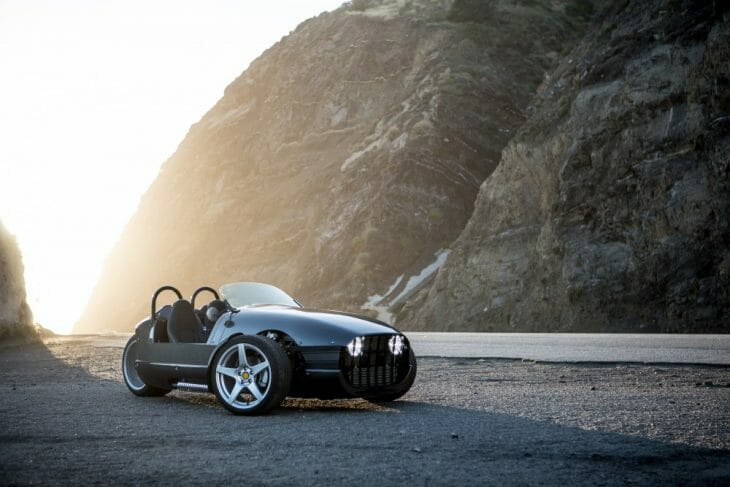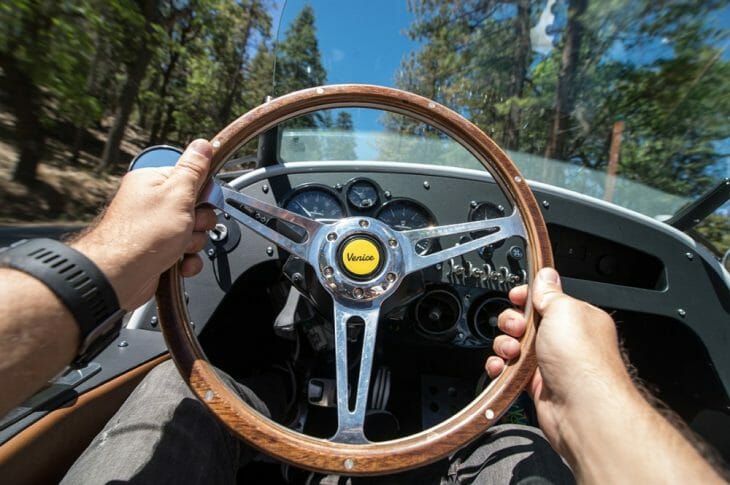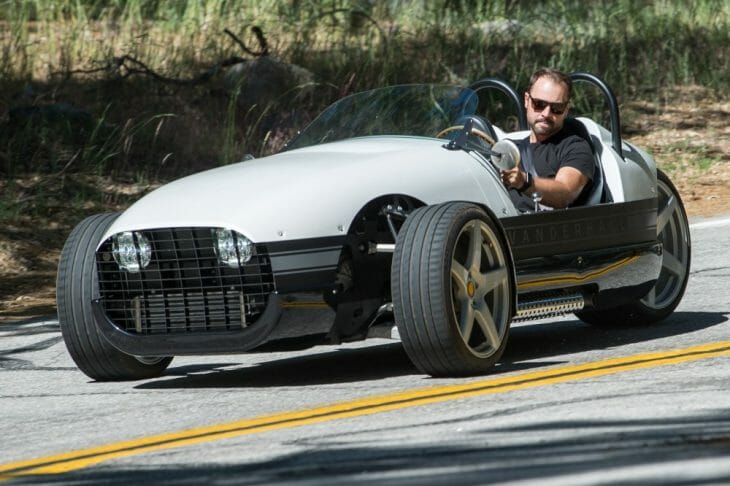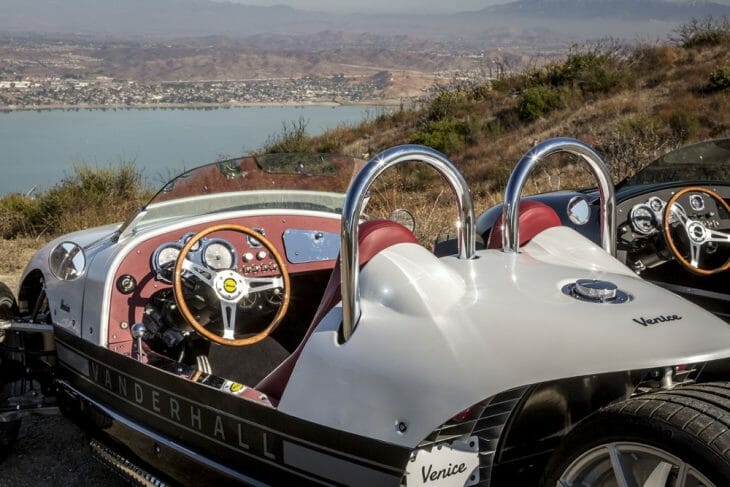Rennie Scaysbrook | July 18, 2017
Before we start, a disclaimer: this machine—the ultra-sexy Vanderhall Venice three-wheeler—is considered a motorcycle by the Californian DMV.
 The Vanderhall sits alongside the Batman-like Polaris Slingshot as a three-wheeled alternative to regular motorcycling–or driving, for that matter.
The Vanderhall sits alongside the Batman-like Polaris Slingshot as a three-wheeled alternative to regular motorcycling–or driving, for that matter.
It’s designated as such for several reasons, not least of which not having to go through the years of testing a four-wheeled machine needs to before it can be driven on our roads.
Dubbed an “autocycle” and considering its motorcycle designation and because we like to test anything that starts with an M and ends in an E, we gave a resounding “yes” when Vanderhall’s Justin Burrow asked if we’d be interested in taking a Venice for a spin.
Three wheelers are those bastard red-headed step children of both bike and car industries. Most of the time they end up falling short of keeping both or any side happy, and I’ll admit to a little trepidation in calling this thing a straight-out motorcycle due to the means at which you control it.
Regardless of my inner feelings at to what the Vanderhall Venice actually is, there’s no denying it’s an alluring machine. Powered by a 1.4 liter turbocharged GM Ecotech four-cylinder engine stolen from a sedan I’m not allowed to mention the name of (it’s not hard if you think about it), the $29,950 Venice is the second tier machine available from the Utah-based startup behind the ultra-expensive, carbon-fiber covered Laguna—prices of which start at about $50K and go up to proper sportscar levels of over $70K for a fully custom-made unit.
 Delightful retro confines take you back to the era of the gentleman driver.
Delightful retro confines take you back to the era of the gentleman driver.
The Venice mightn’t have the price tag of the Laguna but you still get plenty of quality for the money. The ABS Composite bodywork fits tight and snug, exposing the 18 x 8.5-inch front wheels, with minimal tolerances across the aluminum surface covering the chassis. There’s a touch of motorcycle in the chassis and well as the massive 18 x 10.5 inch rear wheel is bolted to a single sided swingarm, in much the same fashion as a Ducati Panigale and uses a single coil over hydraulic shock absorber to keep it under control, with dual pushrod coil over shocks up front.
Enter the Venice via short leap (no doors or even window glass here), and the cockpit is old school gentleman driver, with a delightful wooden steering wheel bolted via a three-star aluminum design with a horn in its center, behind the Venice badge.
The ride experience is somewhat let down by the cheap looking switches littering the dashboard. In comparison to the steering wheel, the dash looks like it was cobbled together using parts left over by other ca…, um, motorcyc.. machines.
The Venice does, however, have a cool little Bluetooth radio that’s hidden from sight and pumps through decent 600-watt speakers, so you don’t have to sit through hours of turbo blowback noises if you don’t want to as you and your passenger bang shoulders together in the rather cozy cockpit.
 The Vanderhall has enough performance to keep you entertained while still being manageable. Having all that grip doesn’t hurt cornering matters, either.
The Vanderhall has enough performance to keep you entertained while still being manageable. Having all that grip doesn’t hurt cornering matters, either.
I, on the other hand, love the sound of a turbo’s blow off valve doing its thing. It reminds me of my youth and all the time spent around morons with Subaru Impreza WRX’s, and the little Vanderhall’s engine does its best to let you know it’s got some sporting balls, too. The transversely-mounted four produces about 185hp/185lb-ft of torque and must shift about 1375 pounds-dry (that’s not including the two heavy occupants on my test drive), so performance is enjoyable if not downright spirited. There’s a discernable turbo lag at about 3500-4000rpm, which is right at the point of acceleration out of the mountain twisties as we head up to Big Bear Lake, but if you keep the Venice on the pipe above 5000rpm and the roll speed up, you’ll be able to cut through corners with supreme speed, not far from what you could do on a real motorcycle (at sane but still license losing speeds).
Our Venice test car comes with the optional sequential gearbox, operated by the shift lever on the left side of the driver’s cockpit, and gives short, precise shifting of the six-speed ’box. The Venice has the standard auto six speeder, but it’s way more fun to go banging up and down the gears using the lever rather than letting the ECU do the talking.
The little three-wheeler will take a fair amount of thrashing before understeer begins to creep in. Hauling up through Big Bear’s many, many turns, the Vanderhall sits heavily on its nose at a hefty 70/30 front weight bias, meaning you can throw it into corners hard and when combined with the ultra-low ride height, it gives you the feeling of piloting a two-person, turbocharged go-kart.
 The cockpit is tight, the wind and engine noise right in your ear, but the Vanderhall still gives you plenty of jollies when you’re blasting up mountain roads. Traffic on a hot day–that’s a different story.
The cockpit is tight, the wind and engine noise right in your ear, but the Vanderhall still gives you plenty of jollies when you’re blasting up mountain roads. Traffic on a hot day–that’s a different story.
There’s a trade-off in this because the low height means you feel every bump in the road and as we drive back down the I-91 to Yorba Linda, it feels like I’ve had about 17 swift kicks up the bum. You also get nailed with every inch of the sun (no kidding, it has no roof!), so crawling home in traffic on a summer afternoon in SoCal is pretty miserable as you and your passenger roast from the outside in.
Knowing this, I had to ask myself a solid question: would I purchase a Vanderhall? If I’m honest, the answer would be no. It’s not really my style. The reason is the Vanderhall drives nothing like and has none of the benefits of a motorcycle while giving you the minimal benefits of a car. There are cars out there that admittedly cost more than a Vanderhall but give better ride quality and far more practicality (although not better performance, which, I must say, is excellent considering the power to weight ratio).
But if I had to choose between this and a trike, no question: I’ll take the Vanderhall.
The Vanderhall is one of those machines—regardless of its car or bike affiliation—that serves no practical purpose other than to be enjoyed. And for that, I give a standing ovation to the Utah-based company. This thing gets looks like no other, sounds great, and has the looks and performance to hold its own against a wide range of machines—both two wheels and four. From where I’m standing, its single purpose is to put a smile on your face, and that is something it does very easily.
 The Vanderhall Venice looks out over Lake Elsinore. For canyon carving, like up Ortega Highway, this thing is a pure joy to control.
The Vanderhall Venice looks out over Lake Elsinore. For canyon carving, like up Ortega Highway, this thing is a pure joy to control.
2017 Vanderhall Venice
Engine: GM Ecotec four-cylinder with a single integrated turbocharger
Displacement: 1400cc
Bore x stroke: 72 x 82.6mm
Compression ratio: 9.5:1
Transmission: GM 6-speed Hydra-Matic automatic transmission
Chassis: Vanderhall Mono Aluminum
Front suspension: Pushrod, coil-over hydraulic shocks
Rear suspension: Single-sided swingarm, coil-over hydraulic shock
Front brake: Dual 305mm discs, single-piston calipers
Rear brake: Single 275mm disc, single-piston caliper
Front tires: 225/40 18
Rear tire: 285/35 18
Wheelbase: 100.4 in.
Fuel capacity: 9 gal
Weight: 1475 lbs (curb, claimed).
Electronics: ABS, traction control, brake assist, steering assist
Color: Metallic Black, Pearl White, Metallic Gray, Red
MSRP: $29,950